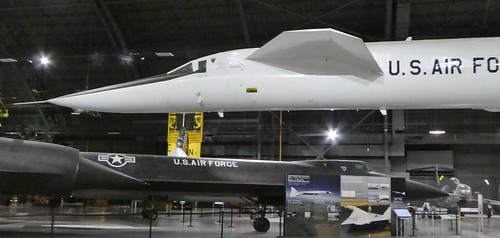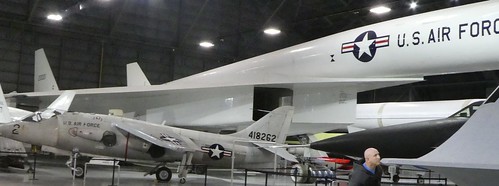Among the experimental aircraft in the Research and Development Gallery in the National Museum of the United States Air Force in Dayton, Ohio is the North American XB-70 Valkyrie.
According to the Museum:
The futuristic XB-70A was originally conceived in the 1950s as a high-altitude, nuclear strike bomber that could fly at Mach 3 (three times the speed of sound) -- any potential enemy would have been unable to defend against such a bomber.
By the early 1960s, however, new Surface-to-Air Missiles (SAMs) threatened the survivability of high-speed, high-altitude bombers. Less costly, nuclear-armed ICBMs (Intercontinental Ballistic Missiles) were also entering service. As a result, in 1961, the expensive B-70 bomber program was canceled before any Valkyries had been completed or flown.
Even so, the USAF bought two XB-70As to test aerodynamics, propulsion and other characteristics of large supersonic aircraft. The first XB-70A, on display here, flew in September 1964, and it achieved Mach 3 flight in October 1965. The second Valkyrie first flew in July 1965, but in June 1966, it was destroyed following an accidental mid-air collision. The third Valkyrie was not completed.
The first XB-70A airplane continued to fly and generate valuable test data in the research program until it came to the museum in 1969.
This aircraft has a top speed of 2,056 mph (Mach 3.1), a range of 4,288 miles, and a ceiling of 77,350 feet.
Note: this aircraft is more than 185 feet long and has a height of nearly 31 feet making it difficult to photograph.









More airplane photo diaries
Air Force Museum: Bockscar, the aircraft that ended World War II (photo diary)
Air Force Museum: The Memphis Belle (photo diary)
Museum of Flight: World War II bombers (photo diary)
Historic Flight: Grumpy (photo diary)
Evergreen Aviation: The Spruce Goose (Hughes H-4) (photo diary)
Planes of Fame: The Flying Fortress (Photo Diary)
Yanks Air Museum: World War II Bombers (Photo Diary)
Museum of Flight: Lockheed Blackbird (photo diary)


